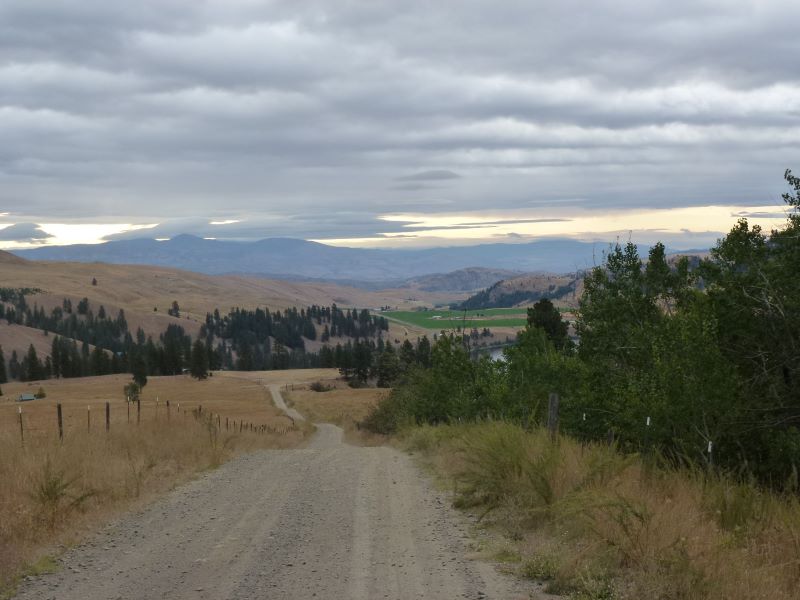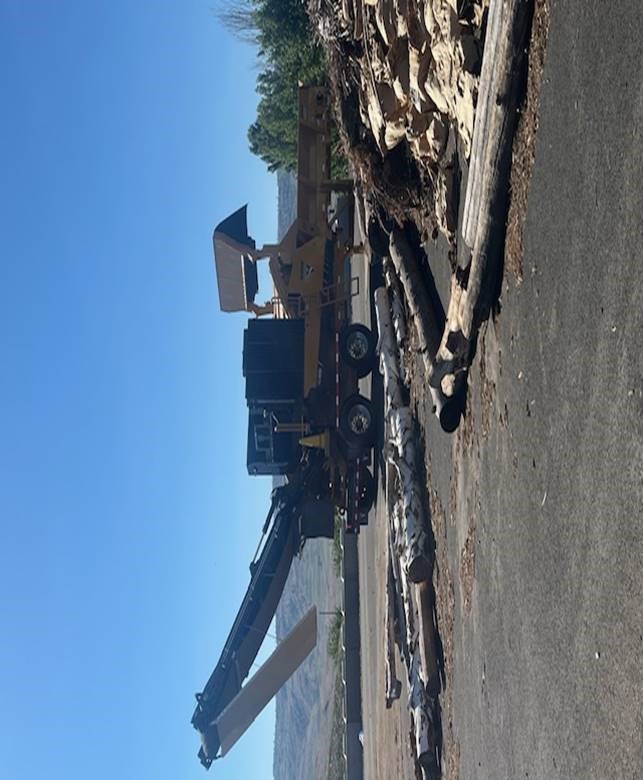
Photo credit Wikimedia: Jake_T53. Okanogan County, WA. 2011
Kent Kovalenko has been an avid conservationist for as long as he can remember. Much of that behavior was inspired by his grandma. “She threw nothing out. Any container she would get, she would find a useful purpose for. I have two quilts made from her old dresses because she didn’t believe in throwing clothes away,” he recalls.
As Solid Waste Manager for Okanogan County Public Works, Kovalenko continues to lead with his grandmother's legacy in mind. He does this by helping implement creative solutions for recycling and waste management. Recently, he helped Public Works spearhead a new initiative for sustainable green waste management that offers free chipping for yard waste as an alternative to burning.
This new initiative reflects a community-wide effort to improve air quality throughout Okanogan County. It is made possible by support from multiple agencies, partnerships, community members, and $2 million in grants from Ecology.
Working smarter, not harder, toward a common goal
Okanogan Valley faces an uphill battle when it comes to air quality, literally! The topography of the valley tends to trap smoke from wood stoves, fireplaces, and outdoor burning close to the ground. Smoke from burning can dramatically increase levels of particle pollution in the air, and especially PM2.5 — particles smaller than 2.5 micrometers — which can lodge deep in the lungs and bloodstream, causing serious health problems.
A smoky haze from orchard burning fills the air in Okanogan County, increasing levels of particle pollution in the air.
In 2024, areas of Okanogan County were at risk of not meeting National Ambient Air Quality Standards (NAAQS) for PM2.5. These standards are set by EPA and required by the Washington Clean Air Act. There are six common outdoor air pollutants that help determine if air quality meets the standard. If any of these six criteria pollutants do not meet the standard, EPA may designate an area as being in “nonattainment” of federal standards. When this happens, strict measures must be taken to improve air quality.
Ecology, local clean air agencies, and Tribes monitor and track emissions to make sure outdoor air quality stays healthy. To prevent an area from falling into nonattainment status, we help reduce pollution. We do this through permitting and compliance efforts, and with grants to local communities. For example, our Prevent Nonattainment Grant Program aims to reduce particle pollution and places a priority on areas of the state at the highest risk.
In the previous Prevent Nonattainment grant round in the 2023-2025 biennium, $2 million was awarded through a competitive grant application process. The three highest ranking applicants were all in Okanogan County. After reviewing the proposed projects, Ecology’s Prevent Nonattainment Grant Coordinator Kari Johnson noticed the top two grant applicants had overlap in their projects. Both shared goals to reduce fine particle pollution from outdoor and orchard burning. Johnson and Ecology finance experts met with the grantees who agreed to coordinate their efforts. As a result, Okanogan County Public Works was able to provide free green waste disposal for the public, as well as for projects conducted by Okanogan Conservation District.
The industrial chipper that Public Works purchased with funds from an Ecology grant.
By coordinating and prioritizing efficiency, we were also able to partially fund the third highest ranking applicant — the City of Okanogan. Their Prevent Nonattainment grant has allowed them to hold more yard waste cleanup events, purchase a stump grinder, and also dispose of green waste for free at the Okanogan County Public Works Central Landfill. This keeps more green waste out of burn piles.
“Because of this coordination, we made sure that work and funding weren’t duplicated and services to the community were maximized,” says Johnson.
A best practice with countless benefits
When introducing anything new, there is an adjustment period. Many people in Okanogan County are used to burning their yard waste or dumping it in the landfill. When Public Works started accepting green waste for mulching in March 2024, with help from Ecology grants, not everyone was convinced that mulching was the way to go. That’s why Kovalenko frames it as a best practice that comes with many benefits, not just for air quality, but also for your time.
“This new program is practical. It’s not good to have organic material in a landfill and you don’t have to burn. It saves you time. You get to go shopping or hiking instead,” he says. Kovalenko recalls how one community member who dropped off two loads of green waste. He explained that burning those loads would usually take him an entire weekend, and that he was worried about starting fires. He expressed gratitude for having his weekend back due to this program.
The program has already taken hold and the impact on air quality is already clear. Kovalenko estimates they have seen around 140% more people bringing in their green waste in comparison to last year. This initiative’s full impact on air quality won’t be known until the closeout report that shows total emission tons reduced during the grant cycle. But Kovalenko knows it’s already having an impact. And because the county has already made progress reducing PM2.5 emissions, Ecology has recommended the area remain in attainment.
Another clear benefit of this program is that all material collected from city cleanup events now gets bagged in paper instead of plastic. Because of Ecology grant funding, Public Works can provide these durable paper bags for free to the cities of Okanogan and Omak. This was a necessary change since plastic bags can’t go through the industrial chipper, also purchased with an Ecology grant. If a composting program ever starts, there will be no threat of plastic contamination. The haulers also appreciate the bags, expressing that the paper bags are less likely to stretch and break, and are easier to use.
Mulch created from people's green waste now lines the trees at Okanogan Landfill, helping to retain moisture.
A beautiful landfill is probably a benefit no one saw coming, except for Kovalenko. He’s using all the newly created mulch to line the trees around the landfill. He also has plans for pumpkins, sunflowers, and watermelons along the tree lines.
“My vision is that when you drive into Okanogan County, you see this oasis of green on the horizon, and you ask yourself, ‘What’s that? Oh, it’s the landfill!’ says Kovalenko. “I’m one of those guys who believes a landfill doesn’t have to look like a dump.”
A green waste triumph with grassroots
This program has been better received than any of the other programs Kovalenko has seen. Critical partnerships have helped pave the way. In addition to partners at Okanogan Conservation District, the Cities of Okanogan and Omak, and general support from community members, the Okanogan River Airshed Partnership (ORAP) has been instrumental in helping this program succeed. ORAP helps reduce exposure to wood smoke in the Okanogan River Airshed by sharing information and identifying and coordinating emission reduction projects. “Without them starting that partnership, I don’t know if we’d be here today,” says Kovalenko.
In the future, Public Works plans to move the industrial chipper to different county pits. This will allow rural, municipal, and residential communities to benefit from chipping green waste. This chipping is improving air quality as more people make the switch from burning yard waste to creating mulch.
“It’s wonderful to see many parts of the community coming together to work toward clean air. We’re happy to support this effort with grants from Ecology,” says Kathy Taylor, manager of Ecology’s Air Quality Program.
The teamwork and collaboration aren’t just nice to have; they're necessary to make lasting change. “It takes everyone doing their part,” Kovalenko says. “In rural communities, you need a community to actually move the needle.”




